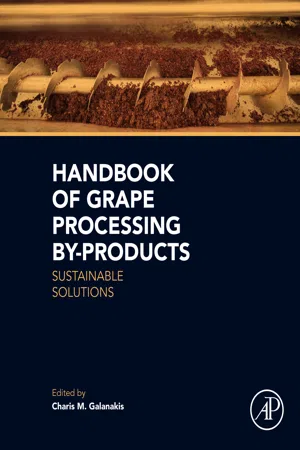
- 326 pages
- English
- ePUB (mobile friendly)
- Available on iOS & Android
About This Book
Handbook of Grape Processing By-Products explores the alternatives of upgrading production by-products, also denoting their industrial potential, commercial applications and sustainable solutions in the field of grape valorization and sustainable management in the wine industry.
Covering the 12 top trending topics of winery sustainable management, emphasis is given to the current advisable practices in the field, general valorization techniques of grape processing by-products (e.g. vermi-composting, pyrolysis, re-utilization for agricultural purposes etc.), the newly introduced biorefinery concept, different techniques for the separation, extraction, recovery and formulation of polyphenols, and finally, the healthy components of grape by-products that lead to target applications in the pharmaceutical, enological, food and cosmetic sectors.
- Presents in-depth information on grape processing
- Addresses the urgent need for sustainability within wineries
- Reveals the opportunities of reutilizing processing by-products in profitable ways
- Explores general valorization methods and separation and extraction methods for the recovery of high added-value extracts/compounds and their transformation to final products
Frequently asked questions
Information
State of the Art in Grape Processing By-Products
* Institute of Oenology and Agro-Food Engineering, Università Cattolica del Sacro Cuore, Piacenza, Italy
** Center for Dairy and Fodder Crops Research, CREA - Consiglio per la ricerca in agricoltura e l’analisi dell’economia agraria, Lodi, Italy
Abstract
Keywords
1.1. Introduction: An Overview on World Grape Production and Processing
Table of contents
- Cover
- Title page
- Table of Contents
- Copyright
- List of Contributors
- Preface
- 1: State of the Art in Grape Processing By-Products
- 2: The Biorefinery Concept for the Industrial Valorization of Grape Processing By-Products
- 3: Vermicomposting of Winemaking By-Products
- 4: Reuse of Vine-Shoots Wastes for Agricultural Purposes
- 5: Extraction of Bioactive Compounds from Grape Processing By-Products
- 6: Membrane Technologies for the Separation of Compounds Recovered From Grape Processing By-Products
- 7: Emerging Technologies for the Recovery of Valuable Compounds From Grape Processing By-Products
- 8: Patent Survey
- 9: Oenological Applications of Winemaking By-Products
- 10: Applications of Recovered Bioactive Compounds in Food Products
- 11: Grape Processing By-Products as Active Ingredients for Cosmetic Proposes
- Index